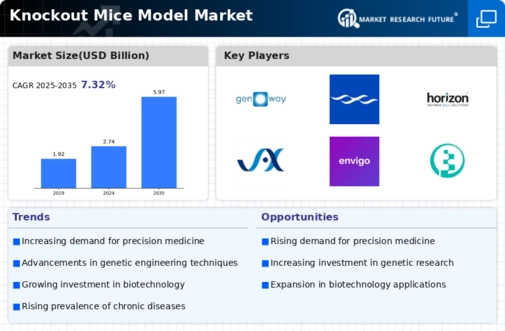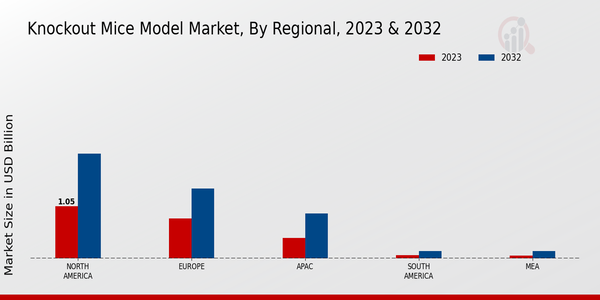Collaborative Research Initiatives
The Knockout Mice Model Market benefits from collaborative research initiatives among academic institutions, pharmaceutical companies, and biotechnology firms. These partnerships often focus on the development of novel therapeutic strategies and the validation of new drug targets using knockout mice. Such collaborations enhance resource sharing and knowledge exchange, which can lead to more efficient research outcomes. As of 2025, numerous initiatives are underway that leverage knockout mice to study complex diseases, including cancer and neurodegenerative disorders. The increasing number of joint research projects is likely to propel the demand for knockout mice models, as they provide a reliable platform for testing hypotheses and validating findings across various research domains.
Advancements in Genetic Engineering
The Knockout Mice Model Market is experiencing a surge due to advancements in genetic engineering techniques. Innovations such as CRISPR-Cas9 and TALENs have revolutionized the ability to create precise genetic modifications in mice. This precision allows researchers to develop models that closely mimic human diseases, thereby enhancing the relevance of preclinical studies. As of 2025, the market for genetic engineering tools is projected to reach substantial figures, indicating a robust growth trajectory. The ability to generate knockout mice with specific gene deletions facilitates the exploration of gene functions and disease mechanisms, which is crucial for drug discovery and development. Consequently, the demand for knockout mice models is likely to increase as researchers seek to leverage these advanced techniques to accelerate their studies.
Rising Demand for Personalized Medicine
The Knockout Mice Model Market is significantly influenced by the rising demand for personalized medicine. As healthcare shifts towards tailored treatments, the need for animal models that can accurately represent human genetic diversity becomes paramount. Knockout mice serve as essential tools in understanding the genetic basis of diseases, which is critical for developing personalized therapies. The market for personalized medicine is expected to grow at a compound annual growth rate (CAGR) of over 10% in the coming years, reflecting the increasing investment in research and development. This trend underscores the importance of knockout mice models in identifying patient-specific responses to therapies, thereby driving their adoption in both academic and pharmaceutical research settings.
Growing Investment in Biomedical Research
The Knockout Mice Model Market is poised for growth due to the increasing investment in biomedical research. Governments and private entities are allocating substantial funds to support research initiatives aimed at understanding genetic disorders and developing new therapies. This financial backing is crucial for the creation and maintenance of knockout mice colonies, which are essential for experimental studies. In recent years, funding for biomedical research has seen a notable increase, with billions of dollars being invested annually. This trend suggests a sustained commitment to advancing scientific knowledge, which in turn drives the demand for knockout mice models as researchers seek to explore the genetic underpinnings of diseases and test potential treatments.
Technological Innovations in Animal Research
The Knockout Mice Model Market is being propelled by technological innovations in animal research methodologies. Advances in imaging techniques, data analysis, and bioinformatics are enhancing the capabilities of researchers to utilize knockout mice models effectively. These technologies allow for more detailed phenotypic characterization and better understanding of the biological implications of gene modifications. As of 2025, the integration of artificial intelligence and machine learning in research is expected to further streamline the analysis of data derived from knockout mice studies. This evolution in research technology not only improves the efficiency of experiments but also increases the accuracy of results, thereby fostering greater reliance on knockout mice models in various fields of biomedical research.


















Leave a Comment